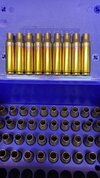GeoDudeFlorida
Member
- Joined
- Dec 1, 2020
- Messages
- 11,055
We joke about the need for shiny brass and varying methods of getting there but it really made me wonder: is there any real advantage to squeaky clean brass versus just cleaning off the lead and dust deposits?
In my experience, clean metal with a light coating of carbon is good. Adding a grease or wax polish is okay for some applications but not others. But just because something works for me doesn’t mean it’s going to work for anyone else. In fact it probably won’t.
I don’t think it’s a real disorder to want shiny brass. Personality disorders are destructive behaviors and polishing brass is not a destructive behavior. It’s just funny to call it obsessive or a compulsion but I don’t think it is either.
Probably not anyway.
What do y’all think? Other than aesthetics is there any advantage to squeaking brass vs just clean enough brass?
In my experience, clean metal with a light coating of carbon is good. Adding a grease or wax polish is okay for some applications but not others. But just because something works for me doesn’t mean it’s going to work for anyone else. In fact it probably won’t.
I don’t think it’s a real disorder to want shiny brass. Personality disorders are destructive behaviors and polishing brass is not a destructive behavior. It’s just funny to call it obsessive or a compulsion but I don’t think it is either.
Probably not anyway.
What do y’all think? Other than aesthetics is there any advantage to squeaking brass vs just clean enough brass?


